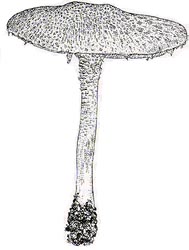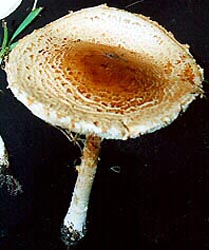|
[ Section Lepidella page. ]
[ Amanita Studies home. ]
[ Keys & Checklist/Picturebooks ] "Nauseous Lepidella" =A. malodora (Murrill) Murrill =A. praegraveolens (Murrill) Singer =A. ingrata Pegler
Technical description (t.b.d.) BRIEF DESCRIPTION: The cap of A. nauseosa is 60 - 220 mm wide, hemispherical to broadly convex to nearly plane, usually with a low broad umbo, dry, white to cream colored to buff, pinkish, or reddish tinged to pale ochraceous buff, with a nonstriate, appendiculate margin. The volva is present as a smooth, continuous white to buff floccose to mealy floccose layer covering the cap, with the palest upper layer disappearing and the remainder becoming areolate by a division into irregular polygons, finally as concentrically arranged, low scales particularly flattened near the margin. The volva may become yellowish brown or orange-brown. The gills are approximate to free, close, and white or frosty white or with a light pinkish tinge. The short gills are attenuate. The stem is 90 - 220 x 10 - 25 mm, narrowing downward or roughly cylindric, often flaring at the apex, whitish at first, and becoming colored like the cap or yellowish to yellowish brown or orange-brown. The volva is often present as pulverulent-floccose and densest on the upper stem and not easily noticed, scattered fibrils on the lower stem, colored and with color changes as on the cap. The spores measure (6.0-) 7.0 - 10.0 (-13.5) x (4.9-) 6.1 - 8.3 (-11.1) Ám and are amyloid and globose to subglobose to broadly ellipsoid (infrequently ellipsoid). Clamps are present at bases of basidia. The spores of this species appear to be unusually susceptible to variation in shape, possibly because of the amount of water present in the environment. Regularly watered areas such as greenhouses produce specimens with the most nearly globose average spores. Amanita nauseosa is very likely to be POISONOUS. Its ingestion has been associated with kidney failure in a single case from Baltimore, Maryland, USA. Unfortunately, I know little more than the species (determined by me from dried material) and the basic fact of kidney failure. This species was originally described from a greenhouse in the Botanical Gardens at
Kew. It is also known to have occurred in the Botanical Gardens at Edinburgh and in Mexico City. The natural range of the
The taxa listed in the previous paragraph, along with A. nauseosa, are assigned to Bas' stirps Nauseosa. Interestingly, A. foetidissima was reported as edible in its original description. (Note: In the map insert, whole states are colored when A. nauseosa has been reported within a state.) The present species is one of the taxa of section Lepidella that are found growing without any apparent woody plant symbiont. -- R. E. Tulloss Drawing: Dr. C. Bas (reproduced by courtesy of Persoonia, Leiden, the Netherlands,
(Bas, 1969))
[ Section Lepidella page. ]
[ Amanita Studies home. ]
[ Keys & Checklist/Picturebooks ] Last changed 11 October 2009. |



 species appears to lie in the Caribbean Region -- both in the island nations and in the states of
Mexico and the U.S. along the Gulf of Mexico. Within its natural range it often occurs in treeless habitats.
Reports from Australia (see, e.g., (Wood,
species appears to lie in the Caribbean Region -- both in the island nations and in the states of
Mexico and the U.S. along the Gulf of Mexico. Within its natural range it often occurs in treeless habitats.
Reports from Australia (see, e.g., (Wood,